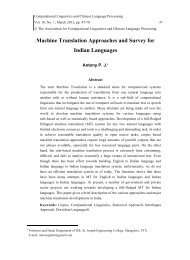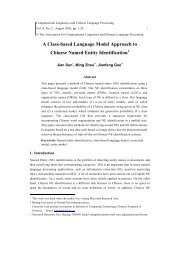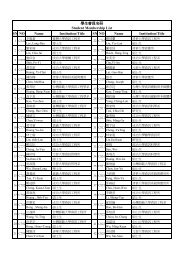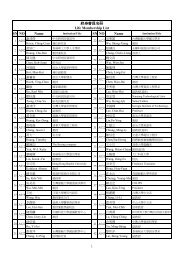Automatic Recognition of Cantonese-English Code ... - Aclclp.org.tw
Automatic Recognition of Cantonese-English Code ... - Aclclp.org.tw
Automatic Recognition of Cantonese-English Code ... - Aclclp.org.tw
You also want an ePaper? Increase the reach of your titles
YUMPU automatically turns print PDFs into web optimized ePapers that Google loves.
296 Joyce Y. C. Chan et al.<br />
The four language models are close to each other in performance because their<br />
differences are mainly on the code-switched segments. The translation approach (TRANS_LM)<br />
achieves the lowest PTT conversion rate. This is due to some <strong>of</strong> the translated <strong>Cantonese</strong><br />
characters not appearing in the character list <strong>of</strong> the original <strong>Cantonese</strong> language models. This<br />
leads to the n-gram probabilities that are related to these characters being very low in<br />
TRANS_LM. The low likelihood affects the decision on the neighboring characters and leads<br />
to degradation <strong>of</strong> the overall conversion rate. Moreover, the code-switched segments are<br />
translated into <strong>Cantonese</strong>, and each translated term may contain more than one character. This<br />
causes a discrepancy in the computed values <strong>of</strong> the PTT conversion rate.<br />
6. Language Boundary Detection<br />
Language identification (LID) is an important process in a multilingual speech recognition<br />
system (Ma et al., 2007). The language identity information allows the use <strong>of</strong> <strong>tw</strong>o<br />
monolingual recognizers. However, the LID for recognizing code-mixing speech is not<br />
straightforward mainly because the speech segments that can be used for decisions are<br />
relatively short. For code-mixing speech, LID can be considered as a problem <strong>of</strong> language<br />
boundary detection (LBD). We consider <strong>tw</strong>o approaches below (Chan et al., 2006).<br />
6.1 LBD based on syllable bigram<br />
The syllable bigram probability <strong>of</strong> <strong>Cantonese</strong> is defined as the probability that a specific<br />
syllable pair occurs. In our study, these probabilities were computed from a transcribed<br />
<strong>Cantonese</strong> text database. In a code-mixing utterance, the <strong>Cantonese</strong> part is expected to have<br />
high syllable bigram probability, while the embedded <strong>English</strong> segments have relatively low<br />
syllable bigram probability, because <strong>of</strong> the mismatch in phonological and lexical properties.<br />
We use a <strong>Cantonese</strong> syllable recognizer based on the cross-lingual acoustic model CL as<br />
described in Section 4. For each pair <strong>of</strong> adjacent syllables in the recognized syllable sequence,<br />
the syllable bigram is retrieved. If the probability is higher than a threshold, this syllable-pair<br />
segment is considered to be <strong>Cantonese</strong>; otherwise, it is <strong>English</strong> or at the code-mixing<br />
boundary. It is possible that more than one <strong>English</strong> segment is detected within an utterance.<br />
Under the assumption that each utterance consists <strong>of</strong> exactly one <strong>English</strong> segment, we need to<br />
select one <strong>of</strong> the hypotheses. Our current strategy is to select the segment with the longest<br />
duration. On the other hand, if no <strong>English</strong> segment is found, the threshold is increased until<br />
the <strong>English</strong> segment includes at least one syllable.<br />
To evaluate the performance <strong>of</strong> an LBD algorithm, the detected boundaries <strong>of</strong> a language<br />
segment are compared to the true boundaries. If the detection errors on both sides <strong>of</strong> the<br />
segment exceed a threshold, an LBD error is recorded. In this study, the threshold was set to<br />
0.3 second. With the syllable bigram based detection algorithm, an LBD accuracy <strong>of</strong> 65.9%









